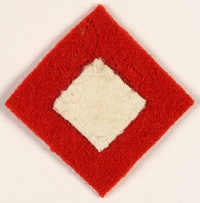
The Lancashire Fusiliers was a line infantry regiment of the British Army that saw distinguished service through many years and wars, including the Second Boer War, the First and Second World Wars, and had many different titles throughout its 280 years of existence. In 1968 the regiment was amalgamated with the other regiments of the Fusilier Brigade – the Royal Northumberland Fusiliers, Royal Warwickshire Fusiliers and the Royal Fusiliers – to form the current Royal Regiment of Fusiliers.
The 45th Royal Tank Regiment was an armoured regiment of the British Territorial Army that fought at the Battle of Alamein during World War II and continued to serve during the 1950s.
The 43rd Royal Tank Regiment was an armoured regiment of the British Army's Royal Armoured Corps that tested and demonstrated specialised Armoured Fighting Vehicles during World War II.

The 42nd Armoured Division was an armoured division of the British Army raised during the Second World War.

The Border Regiment was a line infantry regiment of the British Army, which was formed in 1881 under the Childers Reforms by the amalgamation of the 34th (Cumberland) Regiment of Foot and the 55th (Westmorland) Regiment of Foot.

The 125th Brigade was an infantry brigade formation of the British Army that saw active service during both the First and Second World Wars. It was assigned to the 42nd Division and served in the Middle East and later in the trenches of the Western Front in the First World War. In the Second World War the brigade, now redesignated 125th Infantry Brigade, fought in Belgium and France before being evacuated at Dunkirk and was then converted into 10th Armoured Brigade.

The 144th Regiment Royal Armoured Corps was an armoured regiment of the British Army. Originally raised during World War II as a battalion of the East Lancashire Regiment it was later transferred to the Royal Armoured Corps. It fought in the campaign in North-West Europe, from June 1944 to May 1945.
The 33rd Army Tank Brigade was an armoured brigade formation of the British Army raised during the Second World War.

The 148th Regiment Royal Armoured Corps was an armoured regiment of the British Army's Royal Armoured Corps during World War II. It fought in the invasion of Normandy in 1944.
The 107th Regiment Royal Armoured Corps (King's Own) (107 RAC) was a tank regiment of the Royal Armoured Corps, raised by the British Army during the Second World War. The regiment served with distinction in North-west Europe from July 1944 to May 1945.
The 151st Regiment Royal Armoured Corps was an armoured regiment of the British Army's Royal Armoured Corps that was raised during the Second World War.
The 153rd Regiment Royal Armoured Corps was an armoured regiment of the Royal Armoured Corps, part of the British Army, and was raised during the Second World War. The regiment saw brief but intense action in the invasion of Normandy before being broken up to provide replacements to other units.
Brigadier Philip Ernest Bowden-Smith CBE, was a cavalry officer and later armoured commander of the British Army who served in the First World War and the Second World War. Described as 'one of the finest horsemen of his generation' he also represented Great Britain at the 1924 Olympic Games.
108 Regiment Royal Armoured Corps (The Lancashire Fusiliers) (108 RAC) was an armoured regiment of the British Army's Royal Armoured Corps during World War II.
109th Regiment Royal Armoured Corps (The Lancashire Fusiliers) (109 RAC) was an armoured regiment of the British Army's Royal Armoured Corps during World War II.
The 143rd Regiment Royal Armoured Corps was a short-lived armoured regiment of the British Army's Royal Armoured Corps during World War II.
The 110th Regiment Royal Armoured Corps (Border Regiment) (110 RAC) was an armoured regiment of the British Army's Royal Armoured Corps raised during the Second World War.
The 111th Regiment Royal Armoured Corps (Manchester Regiment) (111 RAC) was an armoured regiment of the British Army, raised by the Royal Armoured Corps during the Second World War.
The 142nd (Suffolk) Regiment Royal Armoured Corps was an armoured regiment of the British Army's Royal Armoured Corps that was raised in World War II and saw active service. The regiment served in the final stages of the North African Campaign at Tunisia and later served during the Italian Campaign from 1943 until early 1945 when it was disbanded.





